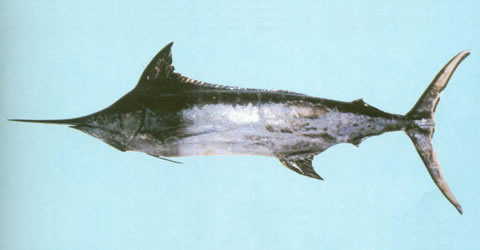| Istiophoridae (Billfishes) |
| 500 cm TL (male/unsexed); max.weight: 170 kg; max.weight: 906 kg; max. reported age: 28 years |
|
pelagic-oceanic; depth range 0 - 200 m, oceanodromous |
| Indo-Pacific: in tropical, subtropical and sometimes temperate waters (Ref. 9692). It is the most tropical billfish species and is common in equatorial waters. However, many scientists do not view Makaira mazara and Makaira nigricans as distinct species, and that the latter species has been considered as a single pantropical species occurring in the Atlantic, Pacific and Indian Oceans. Highly migratory species, Annex I of the 1982 Convention on the Law of the Sea (Ref. 26139). |
|
Dorsal soft rays (total): 40-45; Anal soft rays: 18-24; Vertebrae: 24-24. Body elongated and not very compressed; upper jaw produced into a robust but not very long beak; two dorsal fins, the height of the first less then the greatest body depth, short anteriorly, taller in the middle, then becoming shorter posteriorly; pectoral fins falcate and flexible, with 21 to 23 rays; body densely covered with small, embedded scales with 1 or 2 sharp points; back dark blue, with 15 bluish bars across the flanks; belly pale silver; membrane of first dorsal fin blue black, with dark spots (Ref. 55763). Dark blue above, silvery white below; sometimes with light blue vertical stripes; 1st dorsal fin blackish to dark blue, other fins dark brown with tinges of dark blue in some specimens. Body blue-black dorsally and silvery white ventrally, with about 25 pale, cobalt-colored stripes, each consisting of round dots or narrow bars (may not always be visible especially in preserved specimens). Bill long, extremely stout and round in cross section. Nape conspicuously elevated. Right and left branchiostegal membranes completely united together, but free from isthmus. No gill rakers. Body densely covered with elongate, thick, bony scales, each often with 1 or 2, sometimes 3, posterior points. Caudal peduncle with strong double keels on each side and a shallow notch on both the dorsal and ventral surfaces. |
| Epipelagic and oceanic species mostly confined to the waters on the warmer side of the 24°C surface isotherm and known to effect seasonal north-south migrations. Not usually seen close to land masses or islands, unless there is a deep drop-off of the shelf. Remain mostly within the upper 37 m. Believed to form small-scale schools of at most 10 individuals. Larger fish tend to swim solitarily (Ref. 43) but smaller ones form schools of about 10 individuals (Ref. 9987). Feed on squids, tuna-like fishes, crustaceans and cephalopods (Ref. 9308). Also caught with troll lines (Ref. 9308). The flesh is of good quality and is marketed frozen and prepared as sashimi and sausages in Japan (Ref. 9308); also utilized fresh (Ref. 9987). Also Ref. 9692. |
|
Not Evaluated
(Ref. 96402)
|
| harmless |
|
Source and more info: www.fishbase.org. For personal, classroom, and other internal use only. Not for publication.
Page created by Jen, 05.08.02,
php script by kbanasihan 06/09/2010 ,
last modified by
dsantos, 20/08/10

